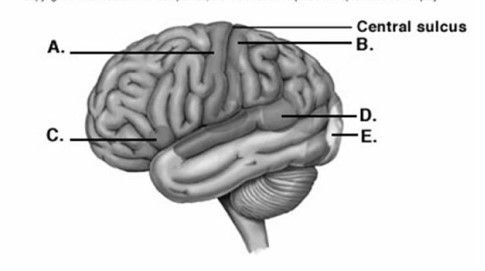A) pain
B) touch
C) temperature
D) proprioception
E) balance
Correct Answer

verified
Correct Answer
verified
Multiple Choice
Match the function with the appropriate structure. -The diagram illustrates sensory nerve endings in the skin.What is the function of "C"?
A) detects deep pressure,vibration,and proprioception
B) responds to painful stimuli
C) responds to light touch and superficial pressure
D) detects touch,involved in 2-point discrimination
E) detects continuous touch or pressure
Correct Answer

verified
Correct Answer
verified
Multiple Choice
Match the function with the appropriate structure. -The diagram illustrates sensory nerve endings in the skin.What is the function of "D"?
A) detects deep pressure,vibration,and proprioception
B) responds to painful stimuli
C) responds to light touch and superficial pressure
D) detects touch,involved in 2-point discrimination
E) detects continuous touch or pressure
Correct Answer

verified
Correct Answer
verified
Multiple Choice
The size of various regions of the primary somatic sensory cortex is proportional to the _______ sensory receptors in that area of the body.
A) size of
B) location of
C) number of
D) size of muscles in
E) position of the
Correct Answer

verified
Correct Answer
verified
Multiple Choice
Impulses that initiate motivation and forethought originate in
A) the postcentral gyrus.
B) the precentral gyrus.
C) the prefrontal area.
D) the association area.
E) the central sulcus.
Correct Answer

verified
Correct Answer
verified
Multiple Choice
Match the term with its definition. -amygdala E
A) the part of the brain involved in the actual declarative memory
B) the largest of the cerebral commissures
C) a factor than activates gene transcription for formation of dendritic spines
D) a series of neurons involved in long-term memory
E) a part of the temporal lobe involved in adding emotional overtones to a memory
Correct Answer

verified
Correct Answer
verified
Multiple Choice
Receptors that in general produce an action potential in response to a receptor potential are
A) phasic receptors.
B) primary receptors.
C) secondary receptors.
D) tonic receptors.
Correct Answer

verified
Correct Answer
verified
Multiple Choice
Which of the following is mismatched?
A) Merkel disks - light touch
B) Pacinian corpuscles - vibration
C) Meissner corpuscles - two-point discrimination
D) Ruffini end organs - temperature
E) hair follicle receptors - slight bending of the hair
Correct Answer

verified
Correct Answer
verified
Multiple Choice
The right cerebral hemisphere
A) receives sensory input from the left side of the body.
B) is the dominant hemisphere for speech in most people.
C) tends to be smaller than the left cerebral hemisphere.
D) contains no association areas.
E) is not connected to the left cerebral hemisphere.
Correct Answer

verified
Correct Answer
verified
Multiple Choice
Match the term with its definition. -corpus callosum B
A) the part of the brain involved in the actual declarative memory
B) the largest of the cerebral commissures
C) a factor than activates gene transcription for formation of dendritic spines
D) a series of neurons involved in long-term memory
E) a part of the temporal lobe involved in adding emotional overtones to a memory
Correct Answer

verified
Correct Answer
verified
Multiple Choice
Rapidly adapting proprioceptors that provide information on the location of a moving hand are known as
A) phasic receptors.
B) primary receptors.
C) secondary receptors.
D) tonic receptors.
Correct Answer

verified
Correct Answer
verified
True/False
The conscious awareness of stimuli received by sensory receptors is called perception.
Correct Answer

verified
Correct Answer
verified
Multiple Choice
Match the sensation with the appropriate receptor type. -Meissner corpuscles B
A) mechanoreceptors
B) thermoreceptors
C) nociceptors
D) chemoreceptors
E) photoreceptors
Correct Answer

verified
Correct Answer
verified
Multiple Choice
Which of the following functions is most likely to be performed by the visual association area?
A) "recognizes" the face of a close friend
B) "sees" the shape of the visual image
C) "senses" pain impulses
D) "moves" the eyes
E) "sees" color
Correct Answer

verified
Correct Answer
verified
Multiple Choice
Specialized muscle fibers associated with detection of muscle length are
A) muscle spindles.
B) Pacinian corpuscles.
C) Ruffini end organs.
D) Golgi tendon organs.
E) Merkel disks.
Correct Answer

verified
Correct Answer
verified
Multiple Choice
Which of the following result when the spinal cord is hemitransected (cut) on the left side? (1) loss of pain and thermal sensations below the injury on the left side (2) loss of pain and thermal sensations below the injury on the right side (3) loss of fine touch and pressure sensations below the injury on the left side (4) loss of fine touch and pressure sensations below the injury on right side (5) loss of fine motor control on the right side below the injury (6) loss of fine motor control on the left side below the injury
A) 1,3,5
B) 2,4,6
C) 2,3,6
D) 1,3,4,6
E) 1,4,5,6
Correct Answer

verified
Correct Answer
verified
Multiple Choice
 -Label area "C" on the cerebral cortex.
-Label area "C" on the cerebral cortex.
A) visual cortex
B) primary motor cortex
C) primary somatic sensory cortex
D) motor speech area (Broca area)
E) sensory speech area (Wernicke area)
Correct Answer

verified
Correct Answer
verified
Multiple Choice
The perception of position and movement of body parts is
A) sensation.
B) kinesthesia.
C) proprioception.
D) All of the choices are correct.
Correct Answer

verified
Correct Answer
verified
Multiple Choice
Lesion of the basal nuclei could cause
A) loss of memory.
B) uncontrolled rage.
C) fluent but circular speech.
D) a slight shaking of the hands or head.
E) loss of sensation.
Correct Answer

verified
Correct Answer
verified
True/False
The simplest and most common type of sensory nerve endings are free nerve endings.
Correct Answer

verified
Correct Answer
verified
Showing 61 - 80 of 132
Related Exams